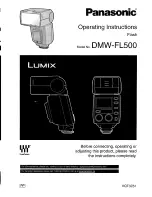
Praktica LTL Instructions for Use
– 9 –
Focusing on the microprism screen
The image in the microprism screen is in correct focus as soon as it appears clear and free from
fuzziness. It is out focus if it looks fuzzy and shows screen elements. The microprism screen is
preferred for focusing if the subject to be photographed is quite still or only slightly moving.
Microprism screen is fuzzy = unsharp
Microprism screen not fuzzy = sharp
Focusing on the circular groundglass area
The groundglass area is used for focusing it there is more movement in the scene. Also, it is often
most appropriate in ultra-close-ups and in photomicrography.
The Fresnel section of the viewfinder is not meant to be used in focusing.
The depth of field is determined by means of the depth-of-field scale (18) arranged on the right and
left of the red indicator on the lens mount.
While the camera-to-subject distance figure stands opposite the red mark, the limits of the range of
definition can be read from the distance scale above the numerals on the depth-of-field scale, which
latter are equivalent to the diaphragm numerals. As an example, the illustration shows a zone of
sharpness from 2 to 5 m (7 ft. to 16 ft.) for a distance setting of 3 m (10 ft.) and an f/8 aperture.
Depress the metering key (2), or
the manual stop down key (15) provi-
ded on most of the lenses, and you
will also be able to judge the depth of
definition in the finder image.
Persons with defective eyesight
may work without their spectacles on
by having a corrective lens correspon-
ding to their long-distance glasses
fitted into the eye cup which is then
attached to the ocular mount (see
Section “Accessories”).
For infra-red exposures the focu-
sing point has to be slightly modified.
By rotation of distance setting ring
(16) the distance reading which, after focusing, stands next to the red indicator, has to be moved to
meet the red dot (infra-red mark). Thus, the image produced by the infra-red rays is brought into
correct position in relation to the film.
K. Releasing and cocking the shutter
Before releasing the shutter, please note the following:
1. Make sure that the shutter release (3) is unlocked (see Section D).
2. If the signal is visible in the left side of the viewfinder,
the camera is not ready for exposing
.
The shutter has to be cocked!
3. For exposure speeds of 1/15 sec. and slower, a tripod and a cable release have to be used.




































